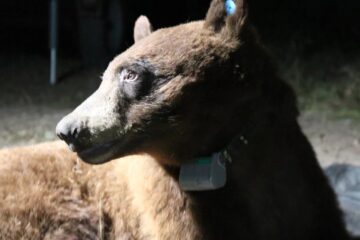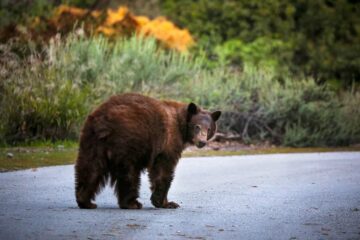ENVIRONMENT: Ripple effect
It turns out wildflowers weren’t the only ones waiting for a rainy day.
Source of this article – Los Angeles Times, April 12, 2005.
By HUGO MARTIN, Times Staff Writer

ECOSYSTEM: Heavy rainfall spawned a vegetation boom, which draws insects and means more food for birds and animals.
THE rain-fueled explosion of wildflowers that has painted deserts, inland fields and hillsides is only the first act of a bigger wildlife show, biologists say. The wettest winter in more than a hundred years, fueled by an El Nino, is fortifying — at least temporarily — the birthrates and well-being of an assortment of wildlife from painted lady butterflies to desert tortoises and mountain lions.
And it all started with seeds — lots of seeds waiting for rain.
Though seed longevity is highly variable among species, many of California’s plants have long-lived seeds that sit in seed banks for tens, even hundreds of years, according to Michael Loik, an assistant professor of Environmental Studies at UC Santa Cruz.
To ensure long-term survival, some annuals produce seeds with thin coats that will germinate during mild winters as well as seeds with thicker coats that can hold out longer. This season’s storms were so strong and long-lasting that they released an unusually high number of seeds.
“But it is important to note,” Loik says, “that the effects [in the ecosystem] are triggered not just by the amount of rainfall but also the timing between the storms.”
The quick succession of storms resulted in saturated soils that in turn saturated the plants. Extra moisture allows budding plants to open their stomata, or pores, longer to perform photosynthesis; in a typical season they’d lose moisture in the process, but not this year. As a result, the growing cycle has been fast and prolific.
More plants have brought more insects. The painted lady butterfly — with its orange, black and white spotted wings — normally breeds twice a season. But according to Martin Byhower, vice president of the Palos Verdes/South Bay Audubon Society, the extra nutrition has allowed them to procreate three or four times, thus fueling the butterfly explosion in the last few months.
“The more food available, the larger the brood,” Byhower says. “It all starts with the rain and the plants.”
The jolt to the plant life has affected the animal kingdom as well. “This richness of resources means [animals] are able to allocate more energy and resources to reproduction,” Loik says.
An example of the ripple effect will be seen in deer mice, a rodent that feeds on seeds and vegetation and is known to carry the hantavirus. Gene Fowler, an associate biology professor at Pomona College, expects well-fed female deer mice to produce bigger and healthier litters of offspring in the next few months.
Another ecological drama is playing out in streambeds. Native species, such as arroyo toads, red-legged frogs, pond turtles and aquatic garter snakes, are uniquely equipped to withstand big rains. They seek higher ground while exotic species are less adaptive, says Samuel Sweet, a biology professor at UC Santa Barbara.
Exotics “stay in the stream during the winter and they get creamed,” Sweet says. “They’re going to come back, but they’ve been knocked back for a couple of years.”
On the trails in the Santa Monica Mountains, hikers are already complaining about clouds of midges that spawn in pools of water and hover over the paths.
Park rangers around the Sierra Nevada warn that wild grasses in the meadows and valleys are taller and more abundant, providing an ideal perch for ticks to jump onto passing animals and humans.
In parts of the Mojave Desert, the heavy rainfall and moderate temperatures have created a rare desert phenomenon: stagnant pools of water, choice breeding grounds for mosquitoes.
Further up the food chain, animals such as mountain lions and bobcats will be well-fed and healthy over the next few months from eating mice, rabbits and other small creatures.
Carnivorous animals don’t breed as often as insects and thus the extraordinary seasonal conditions probably won’t alter their reproductive cycle, he says.
Meanwhile, back at the bottom of the food chain, the annual wildflowers are already starting to whither in the deserts and flat-lands and in the process, are casting their seeds out into the world. Although there is no predicting when another spring such as this one will occur again, the increased vegetation is raising concerns about future fire seasons.
“More rain means more vegetation, which when it dries out is more fuel,” Loik says. “That fuel may bum this fall, or it may be years until a fire happens in a particular location.”


